-
Posts
448 -
Joined
-
Last visited
Content Type
Profiles
Forums
Articles
Gallery
Downloads
Events
Posts posted by templehound
-
-
On 11/26/2021 at 9:53 PM, Les L said:
Amazing, as always.
Les L thank you very much appreciated!
-
I usually have completely ground blades without a finish on my workbench for a while.
As a result of this, they are also repeatedly used for cutting work that occasionally occurs at the workbench.
That can say something about their potential ... relatively, of course.
The 2419.05 has undoubtedly "articulated" itself here more often. and often achieved amazing performance.
Reason enough to make a test knife out of it.
Grinded to 0.10 mm, the cutting edge nails the bare thumbnail clearly and is so disgustingly sharp that you can feel it
could ask whether that's too much of a good thing .... no matter what kind of steel, if it's so thin you should look at the area of application and
think about the stress well ... the 2419.05 has enormous edge stability and keeps the fine sharpness in such a way that you get the impression that the steel is thinking for you.
I used a scrap of wood that I found in the jungle a few months ago .... and I have no clue what kind of wood it is .... Extremely hard, fine-pored, mustard-colored and very willing to work with.
As a shape I chose a small flat tang puukko with a fluted barrel handle ... this handle shape combined with this texture has a
impressive feel ..... and the sheath had to have a clip.
Without its advantages and carrying options, I would not put it in and take it with me ... this makes it clear that a good knife
with a functional sheath becomes a better knife .....
These properties are the prerequisite that a knife is used often and often and only then is it meaningful as a test knife.
Cheers
-
-
swedefiddle and Daswulf already said it well.
I like to say according to what they wrote
Recycle leaf springs is more expensive than buying fresh stock....anneal, normalize, stress relief and straighten springs means time, money and effort....and loss of carbon!
If you forge The time you finished you don't have 0.6% carbon anymore ...depending on how good and fast you are....who wants to start with less than 0.6 carbon, which is
pretty less already.
Better start with fresh stock and the price per kg must be around 3-4 dollars?....in Germany it is about 3.50 Euro....compared to something real good like O7
that has a kg price at about 13 Euros, 5160 is really the cheap stuff....
5160 has lots of silicium for elasticity, Si makes it hand forge difficult and lowers resitance to wear, impact value and machinability ....both needed for a good blade material...
so like another knife maker once said: "....you can make a blade of leaf spring steel but it will not make a great blade.".....he is right, and I say
it will not even make a good blade....if you prefer tough blades that not keep an edge for a minute than maybe it can be seen as a good blade.
but 52100 is tough as well, and 1.1274 and 100V1 and 2552,2550, 2442....all those steels can result in super tough blades if heat treatment and above all, edge geometry
are propperly executed.
Now I fear it will get to railroad spikes?.....
 ....just kidding....I hope it will not.
....just kidding....I hope it will not.
Cheers
-
Thanks for the nice comments Gentlemen, much appreciated!

Mr. Slag: I think your question is already largely answered. I may add that the bark mostly is the enamel .So the stronger/harder part of the tusk.
There are two different outer layers on a tusk or tooth.The cementum is the outer layer covering the dentin in the root area, the enamel is the outer layer that
covers the dentin in the crown area.
-
I googled "Disadvantages of slipjoint knives" because there are simply no advantages in slipjoint knives except better than no knife, flint blades or friction folders.
I was just curious if something would come up that I don't know yet
and the first meets my eye was in " People also ask" -Are slipjoints safe-....that made me grin.
But what I didn't knew was that they are around since 1660 and that's a very long time.
So it's all about nostalgia and they are practically legal in most countries ....an advantage hidden in the disadvantages

Knife laws made the slipjoint rise again at least in Germany....
On this one blade, spring and bolsters are made from 1.5634 (75Ni8) bandsaw steel, steel pinned mammoth bark, German silver for the liners
and instead a nail nick I made a fuller.
Cheers
-
On 9/17/2021 at 12:46 PM, JHCC said:
What are your thoughts on this?
Larrin Thomas is really good.....I agree with him as far as my humble practical experience confirms
Considering the overall information we got, there is an incredible range of different hardness on the blades
that are able to cut a nail or steel parts.
Richtig's blades:.....They also measured hardness for the knives with the large knife ranging between 36-46 Rc with an average of about 39 Rc and the small knife 40-56 Rc with an average of 50 Rc.
Shawn Houston, CPM15V, 67 HRC !
https://www.youtube.com/watch?v=bliUWSXm09o
the blades that perform well in that kind of cutting test are so different ...that is fascinating
so it is not the alloy, not the HT, not the hardness that only leaves the geometry and....."how" the blade is pounded into that cutting object.
a few years ago I experimented on that subject and diced up nails with a blade.
It performed really nice the first 7 or 8 cuts, than it chipped from one side of the edge.
I realized that I became sloppy in the angle of holding the blade and hitting its back.
that made my blade fail.
so I think Larrin Thomas is as close as revealing "the secret HT" of Richtig....geometry, skills and showman ship...
for all the live performances and sensational events he performed he had to give the thing a name
seems that the HT fitted the best...."HT" means heat treatment or we could understand it as
The secret "how to" of Frank Richtig...well, just fooling around with words.
-
8 hours ago, Irondragon ForgeClay Works said:
Great article thank you for the link.
I second that, Thanks for the link, Buzzkill!
-
Daswulf,
maybe You know this article already, but it is worth to post a link.....in the 1930's Frank Richtig did some performance that could not be matched until today.
It is fascinating how thin on the edge and how different hard his blades were...there must be some manual skills how accurate in angle and speed the blade is driven into a chunk!(not a nail!) of steel....he never gave up his secret until he died, ....imaging the bragging of modern knife producers if they could do the same performance...

https://knifesteelnerds.com/2019/07/08/frank-j-richtig/
7 minutes ago, Irondragon ForgeClay Works said:Like the FIF tests. We will cut an Abrams tank in half, then split an atom with your blade.

I love watching FIF....very entertaining and "cringing"...
 ...always fun watching and try to predict what will happen.
...always fun watching and try to predict what will happen.
-
On 9/11/2021 at 1:58 PM, SlimW said:
you make it look easy. if only it actually was.
I mean, the grinding alone...beautiful work.
SlimW, Thanks for the nice comment!
Well, to be honest....I never felt that grinding a knife blade was or is easy...of course it depends....
the difference from a piece of crap to a good blade is space for plenty of results.
-
On 9/9/2021 at 10:21 AM, Daswulf said:
Cutting nails with that thing. I really cringed. That is a test beyond normal use. ......it hurt to watch.... I would never ask a knife to chop nails. Even if it could as this one does.
On 9/9/2021 at 11:47 AM, Frosty said:I'm with you Das, I almost couldn't watch and now he's torturing us with a pic of diced nails!
Daswulf, Frosty: I cut nails 12 times and I felt some discomfort every cut, even I knew it was fool-proof
 .....normally I would not ask a blade to perform this either.
.....normally I would not ask a blade to perform this either.
...even if I know the blade could take it....but I needed some "cringe" or "excitement" for the video with a context
to the "geometry and HT are more important than the alloy"- subject.....Thanks for your contributions, Guys!
-
-
I decided to make a film about a knife....that didn't work out, so I made a knife for a film and that turned out better.
The "plot" describes the philosophy of the mechanical advantages and properties of the construction and the knife, ... as there would be:
Heat treatment and geometry are more important than the alloy, the sense and purpose of real ferrules in hidden tang knives, the advantages of a laminated wooden handle,
the high performance, the handling, the balance, and last but not least the advantages of the sheath and its structure.
Capturing the atmosphere of the environment and making and performing own audio tracks was indispensable and vital.....so, here is the film about this knife, it was an unbelievable amount of work, took me 1 1/2 years to make and ruined 2 1/2 cameras and my PC is drowning in a chaos of
files, folders, audio and video tracks and pieces....I even cannot remember what they are all about, but that's not important anymore.....
here it is,... 30 minutes of "spiritual" distraction....

https://www.youtube.com/watch?v=HCWHDekWt0o&t=4s
-
Thanks a lot, Anvil!

-
Thanks Frosty, much appreciated!

-
On 4/8/2021 at 8:06 PM, jakuuys said:
and trying to figure out all the mechanisms
....that is such a broad question....imagine how much we have to write, explain, answer etc to nail that.....
....you checked the internet?

...most of liner locks can be "flipped"...
-
During my education as a traditional German cutler and blade smith I had to do slip joints.....and I didn't like them at all.
There are a lot of do's and don'ts on slipjoints ...from limited using range to the fact that they are very hard to clean....
Also the very small design range when making them....compared to a linerlock they must loose in every aspect.
(actually it would be more appropriate to compare linerlocks with backlock knives, but I compared them just under the term of folding knives.)....
....and yes, not to forget: we are not supposed to let them snap back into the handle....a good crisp, long lasting spring has a strong snap
and the edge will thereby hit the spring and get a nick.....reason for the monstrous kick heels on some traditional pocket knife patterns
....as You for shure know....nevertheless the heels, it can smack the edge.....so do not let the blade snap into the handle.
But that's the half part of the fun...
...and this is the reason I love them nowadays....the are great fun to make....somehow they are like a toy to me....
maybe they are the most useful toy that exists.
They walk and talk with a strong whack when they are opened and a good snap when they are closed....There are plenty of challenging things on the making of a slip joint, like for example, to design them that You can let the blade snap back into the handle...
If the linguistic and rethoric context is slightly adjusted in a translation of the term "slipjoint knives", in three languages of English. German and Thai,
it can result in "Jumping joint jack knife" ....so it is the "Jumping Jack"
Here is a traditional one in O7 steel for blade and spring, some crap steel for the bolsters , German silver liners and fossile bone handle slabs.
here You can hear it talking and see it walking
https://www.youtube.com/watch?v=qcb_Sp0QOrw
Stay healthy
Cheers
-
I once red an article written by Ed Fowler.He cold forged mild steel to a decent blade.In this case Cold forged means reallly cold forged like hammering the edge of a scythe.
no fire and heat just patiently hammering the blade.....it showed good results, not a winner in edge holding but because of the fine grain fairly tough and as good as it can be used....but horse shoes still got their holes

-
Thats a solid user! The materials 1095 and canvas micarta are nearly indestructable....and You got a nice design with a pleasing agressive tension in the spine line.
....and a nice form on the handle as well....
I see You had or maybe had some struggle with the blade finish....a bit too uneven and coarse, but maybe You wanted it that way because the finish is first to be ruined on a user that will see field action....cutting through hay wire a sheepfoot blade came immediately to my mind....but sheepfoots are not the blade forms that win the beauty contest and that curved skinner is much more attractive ....and with its large belly this blade will get the job done pretty well.
Cool knife!

Cheers
-
That piece deserves more than zero replies in 5 Days....

regardless of the facts that this piece is actually not my taste I have lots of respect for the amount of the work
and how consequentlyYou made it according to the guard and especially the sheath....such sheaths can be real butt kicking devices.
As well as the fluted work on the handle and keeping it symetrical in all parts...!
I could imagine getting the brass a bit dirty with some patina and gun blue the blade....it will make it look more sinsister and mean...because this is a mean tool.
In my eyes polished brass( or bronze) always looks cheap, but not all people like it antique like me....we are only slaves of our taste.
Overall very well done!
-
Thomas and IrondragonFCW, Thanks for the kind words!
George N.M.: thats North American Native indeed.The backing track is music from my band from younger times.We mixed it together with some Native chanting which
came from an old casette tape.As far as I can remember it is a Navajo marriage chant....they always sing in major, it will walways sound good to major rock music.
rhitee93: ...there You said something
 my left arm swung away from the cutting goods, same direction as the swing.If my left arm would swing towards the blade or the cut, then I would be worried too.Left hand and blade are almost a wingspan apart, no way I could hurt myself.
my left arm swung away from the cutting goods, same direction as the swing.If my left arm would swing towards the blade or the cut, then I would be worried too.Left hand and blade are almost a wingspan apart, no way I could hurt myself.
there are more cutting tests as You will see in the upcoming film, most of the time my left arm is folded to my chest.Like in boxing when you throw a right punch your left
hand should take instinctively high guard.head protected, limb out of the way and very important, maintaining body balance.
I never agreed putting one arm behind the back while chopping.IMHO it gives muscle tensions on the left side that negatively affects the body balance and thus also the accuracy of the blow...but, IMHO like I said, someone else may feel differently....rhitee93 Thanks for the good comment!
 ....what does it mean?...Take this FWIW
....what does it mean?...Take this FWIW
Glenn, Frosty, M.J.Lampert:....no chainsaws and chickens will show up...Frosty: what does "10 IIRC" mean?
But I agree Gentlemen,...nothing more dangerous like a chainsaw...its like a cocked gun placed on a table...so do not slam on that table!

Cheers
-
I started at the end of last rainy season and now at the beginning of the new monsoon I am nearly finished.
You all stay healthy
Cheers

-
-
For the second knife that turned out pretty good....thats what came immediately to my mind.
As a suggestion or stimulus I would recommend take a look and give a thought in size and design ratio....that design is too much like a spade.
It is for most tasks too wide, whether you peel an apple or dress game while hunting.Maybe You can skin with it but when releasing bones out of joints there is simply
not enough space most of the time for such a broad blade.....and it would aesthetically look better if not that broad.
I dont know if I understand it linguistically right, that you blame the 1084 for the grain structure and thinking with another 1095 it would be better.
It is not the steel that is responsible for coarse or/and inconsistent grain....well, it is You and your technique in heat treatment
Heat treating with the forge is something for the more experienced maker....but I dont recommend it. It is not accurate!
Even after 30 years of forging and knifemaking I never would heat treat without a kiln or oven and a proper thermometer...heat treating is with edge geometry
the most important thing to get a good quality knife....it has to be controlled and it has to be clean....HT with the forge without experience is not more than guessing,
resulting in uneven solution, coarse grain, cracks, pollution and the like
And I really dont understand the term " soaking" ...do you mean the time holding the steel in temperature? If so, the old school and classic technique
for time of a knife blade holding in the oven is 1 minute per each millimeter.
If you have a blade with 5 mm in thickness, it is the first minute getting it up to temperature and then holding it for 5 minutes.
Before You put your focus on bevel looks and finish get the geometry and the forms a bit better under control...starting with the edge. It is still much too tick.
near the ricasso it is a thick wedge....and the picture from the back shows the tip ist still blunt and thick and not pointy.
Well, that's what I call a clear criticism, but it is well-intentioned, hope you understand it right and get some advantage out of it.
Like I said at the beginning for the second piece you did really good....if You focus on the real high performance quality, because thats what all handmades should have, You will be a skilled and very good maker....you got good basics already
good Luck
Cheers


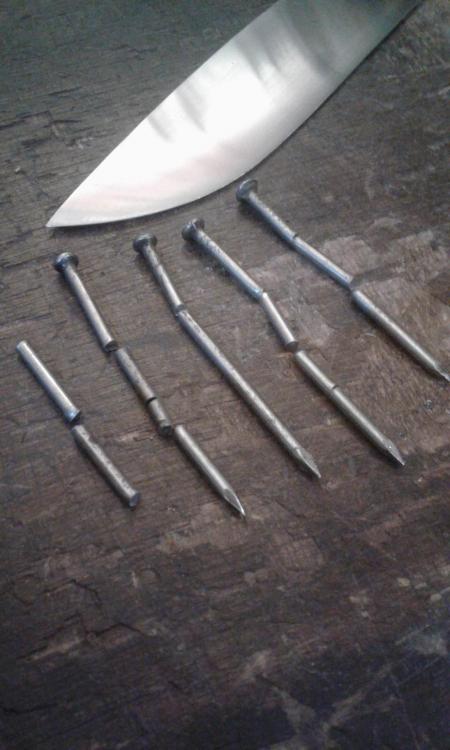
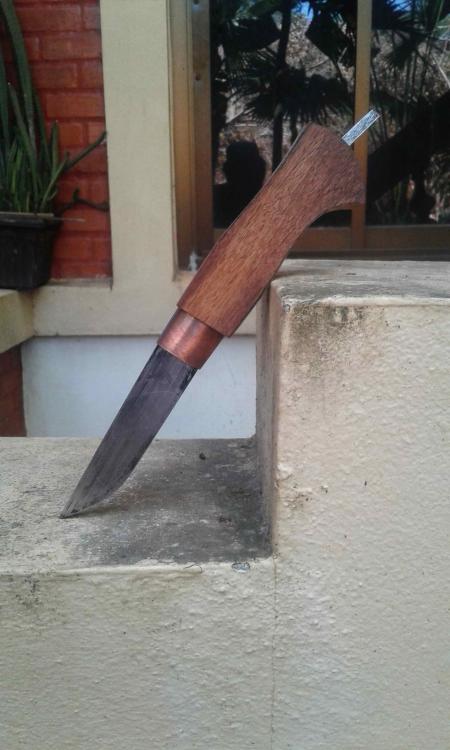
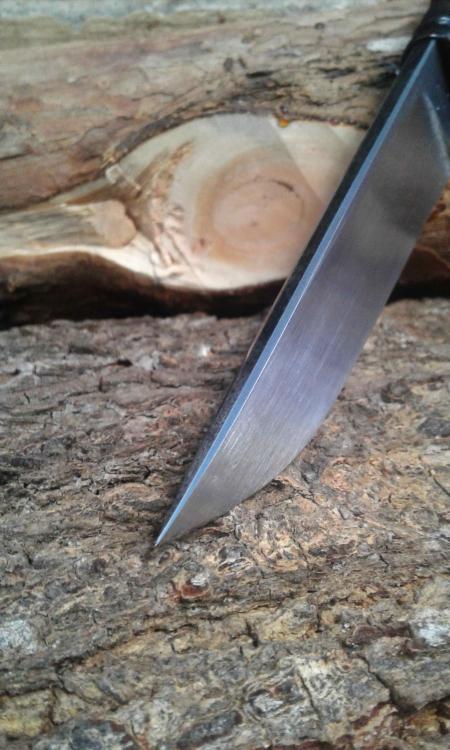
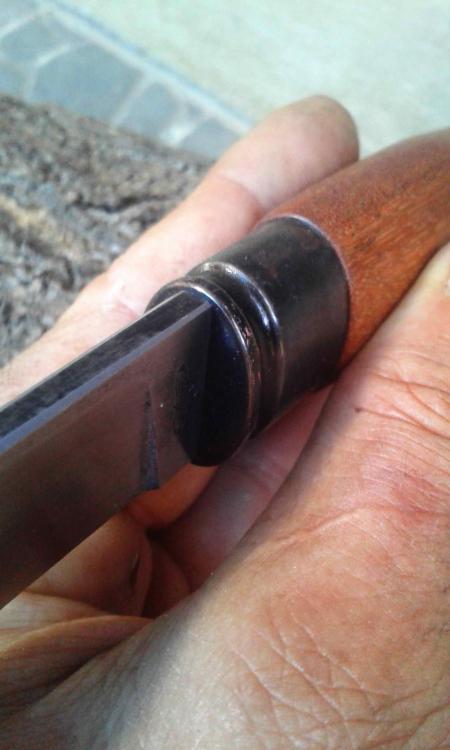
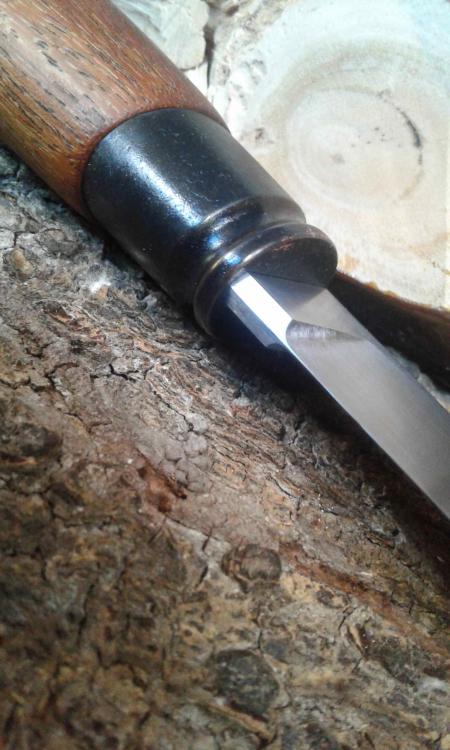
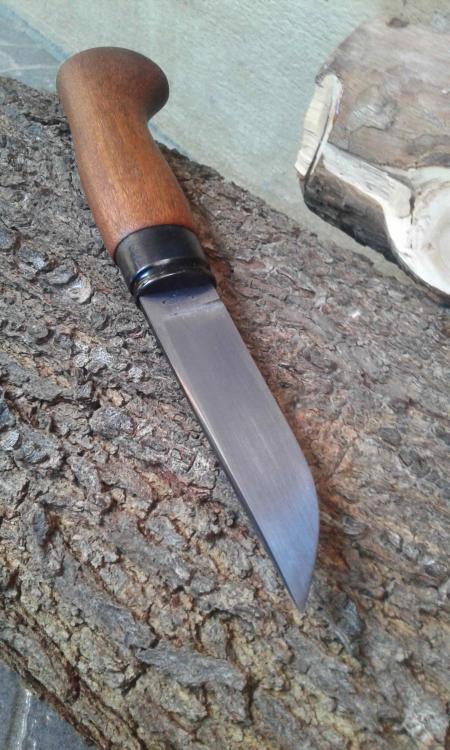
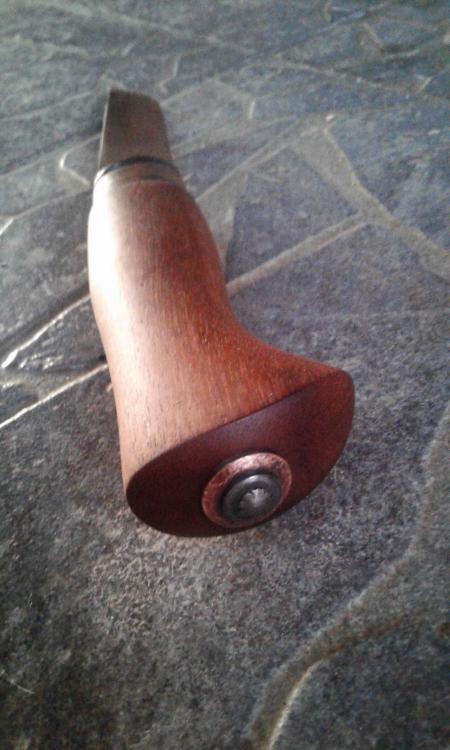
Damascus Copper or Brass added to knife blade?
in Knife Making
Posted
This maybe what You looking for.
A good fellow in the German knife community makes them very skilled and really nice.
https://www.bladecommunity.de/forum/thread/19140-kupfer-und-damast/